Have you ever been pleasantly surprised to open what you thought would be a generic brand email to see that it contained a personalized message? For example, receiving a discount code for that piece of furniture you were eying on their website earlier — and recommendations for accessories you could order online and pick up at your local brick and mortar location?
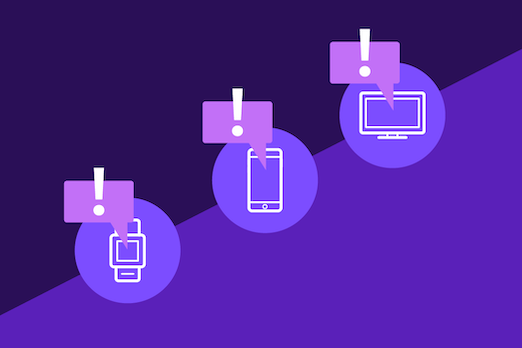
That’s because you were on the receiving end of a thoughtful omnichannel experience, which is unfortunately all too rare in this day and age. But, with a little education and effort, it doesn’t have to be rare in your organization.
If you want your marketing program to be the one that leaves a smile on consumers’ faces, it’s time to develop a strategy for delivering powerful omnichannel experiences.
In this guide, we’ll help you do just that by answering your burning questions about omnichannel experiences and showing you:
- What a real-life omnichannel marketing experience looks like from the consumer point of view
- The trends that have made omnichannel experiences a must for modern businesses
- Three strategies you can implement to boost your experiences from multi-channel to omnichannel in just a matter of weeks
Keep reading if you want to learn how to take “omnichannel experience” from a buzzy phrase to a worthwhile strategy and position your marketing department as an indispensable profit center.
What Is an Omnichannel Experience?
If you’re already using various channels to deliver your marketing campaigns, you’ve mastered the concept of the omnichannel experience, correct? Close, but not quite.
A multi-channel marketing experience is when a consumer interacts with your brand on more than one channel. So while they may engage with your marketing emails and the product content on your mobile app, they’re not enjoying a personalized or continuous experience as they move across each of these channels.
An omnichannel experience isn’t only about the variety of channels; it’s also about how they provide a cohesive flow for each consumer.
The omnichannel experience integrates each of the channels through which you provide marketing — from in-store sales agents to social media platforms to digital devices such as smartphones — in a way that enables you to provide a seamless and personalized experience for each consumer.
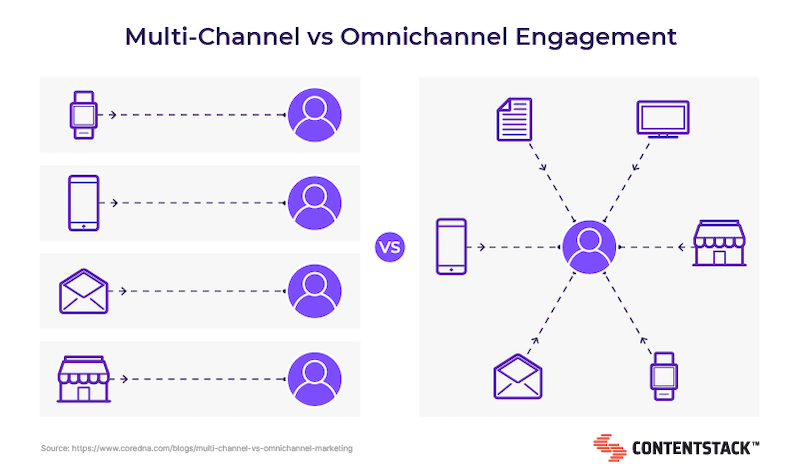
It’s no longer as simple as spreading your marketing efforts across multiple channels. Multi-channel marketing can still leave consumers with fragmented information and a lackluster brand encounter that doesn’t move them closer to becoming paying customers.
Today, effective marketing is about providing omnichannel experiences that put the consumer at the center of the interaction to provide a captivating encounter that generic, fragmented marketing can’t touch.
What Does an Omnichannel Experience Look Like in Real Life?
Today’s buyer’s journey is neither predictable nor linear, which is a critical reason why omnichannel marketing is necessary. See how our example consumer, Chen, may interact with a brand that provides an optimal omnichannel experience. Chen knows she wants to purchase a new laptop. So she pulls out her smartphone to do some research on the options at a local store. While on the store’s mobile-optimized website, Chen interacts with an automated chatbot to set up an appointment to check out a product in which she’s interested.
When Chen arrives for her appointment, an in-store agent has the laptop she’s interested in ready and waiting for her to try it out. Chen likes the laptop but doesn’t buy it right then and there because she thinks she can probably get a better price after shopping around for a while. But while casually looking at Facebook on her tablet the next day, she receives a personalized ad from the store offering her a discount for the same computer she wants.
Chen clicks on the ad and is directed right to the laptop’s product page on the store’s tablet-optimized website, where she completes her purchase. After the discount and delightfully easy transaction, Chen is in an upbeat mood and also signs up to receive marketing emails from the store.
Chen is pleased when the first email comes from the store (after the one notifying her that her computer has shipped), including the recommended accessories based on her laptop purchase and her previous shopping behavior on the store’s website.
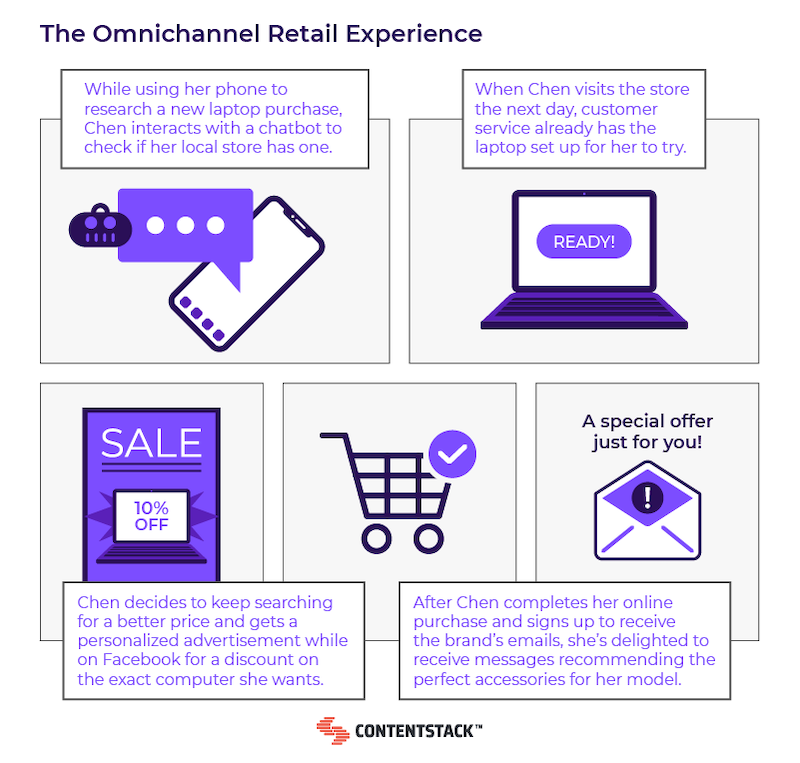
Chen offers a realistic example of modern consumers and how they want to interact with brands as they conduct their digital lives across different channels and devices.
Unfortunately, the computer store in our example offers an ideal version of the omnichannel experience that many brands aren’t quite prepared to deliver today. If Chen’s story isn’t enough to convince you that it’s time to upgrade your marketing to provide omnichannel experiences, consider the following facts.
The Trends That Prove It’s Paramount for Your Brand to Offer Omnichannel Experiences
The biggest reason brands must provide omnichannel experiences is that modern consumers demand them. A 2020 survey found that the average American has access to over ten internet-connected devices in their household. What are they doing with all these smart devices? They are engaging with brands to get the products and services they need at an increasing pace.
We know this because, at the start of the 21st century, consumers interacted with an average of two touchpoints to complete a purchase. Today, consumers interact with three times that for an average of six touchpoints before making a purchase.
And what is it that consumers expect when using all these devices to interact with brands across various touchpoints? A consistent omnichannel experience. The majority (almost 60%) of people who consume content on the internet expect companies to provide consistent information on every brand channel. Over 60% are either not likely to or will never continue shopping with a brand that offers an experience that doesn’t live up to their expectations.
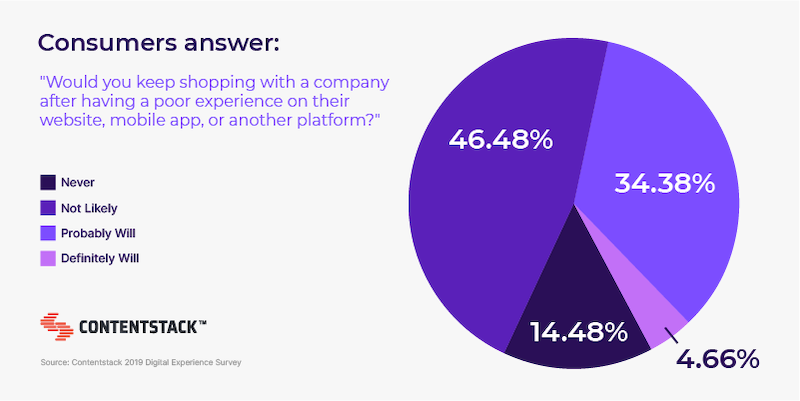
But it’s not only about shopper demands. There are plenty of compelling reasons why businesses deliver the kind of omnichannel experiences their consumers have come to expect. For example, brands that prioritize omnichannel experiences can achieve an average customer retention rate of almost 89%. And these companies can also reach an average of 9.5% revenue growth year-over-year.
Compared to single-channel shoppers, omnichannel consumers spend an average of 4% more on every in-store shopping trip and 10% more online. They also have a 30% higher lifetime value and are more likely to recommend your brand to other shoppers.
The next section explores several ways to improve your marketing strategy to reap the rewards of providing a robust omnichannel experience.
How to Take Your Brand Marketing from Multi-Channel to Omnichannel Experiences
Implementing an omnichannel marketing program can have its share of complexities. However, that doesn’t mean putting the processes in place to go omnichannel has to be complicated. Any marketing team that is ready to put in the effort can employ the following three strategies to go from multi-channel to omnichannel in just a few weeks.
Understand How Customers Experience Your Brand Across Channels
Aside from the technology for delivering omnichannel marketing, one of the essential elements of creating compelling omnichannel experiences is knowing how consumers interact with your marketing. Once you understand that, you can identify areas for improvement.
This process all starts with doing something referred to as “mapping” the consumer journey. Essentially, you make a list of the touchpoints where consumers interact with your marketing. For example, a customer might click on a social media ad, land in your knowledge center after a random Google search, or might search for a specific product page after hearing about your brand from a friend.
Don’t be afraid to look outside of the marketing department and enlist everyone in your company who works with customers and may have some insight here. Think customer service, sales, and beyond. Another way to create this list of touchpoints is for members of your team and hired usability testers to go through various consumer journeys on their way to achieving different goals, documenting marketing touchpoints along the way.
If making this list proves to be an overwhelming task for your limited resources or time frame, prioritize identifying the touchpoints closest to the goals you have for people who consume your content, such as subscribing to marketing emails or making a purchase. By understanding how consumers are interfacing with your brand and marketing messages, you now have a project to rally the team around.
Bring Your Team Together to Improve These Omnichannel Experiences
After your team has taken the time to dive deep into all the ways consumers interact with your brand across channels and devices, it’s time to review each touchpoint and decide if and how you can improve.
Here are some questions to ask about each touchpoint to rate its current performance:
- Did the marketing message at the touchpoint help you achieve your goal?
- Did the touchpoint move the consumer to the next intended point in the customer journey?
- Was there anything at this touchpoint that might have turned the consumer away?
- What was the touchpoint missing?
- Could advanced personalization have added to the experience?
Suppose you are having trouble evaluating your omnichannel experience touchpoints. You might try repeating the same consumer journey mapping process as above, but this time on a competitor’s digital channels. Knowing how the competition handles similar consumer interactions may help you see where touchpoints are underperforming.
Your goal in this step is to identify how to improve consumer interactions with your marketing across channels. These interactions should include before, during, and after the buying journey. For example, there’s little point in optimizing the ease of purchasing a product if your marketing campaigns are dropping people on landing pages from which they can’t navigate to the products they want.
Next, you must put a plan into place to make these improvements, which will likely pull in people from all over your organization. For instance, you may need user experience designers to update website workflows, copywriters to help make sales messaging more effective, and so on.
Suppose you find that making this concerted effort to adjust your omnichannel experience manually isn’t enough to meet consumer demands and reap the rewards you want. In that case, there is a power move you can make to boost your omnichannel marketing experiences.
Power Up Your Omnichannel Experiences with a Headless CMS
Most businesses with a dedicated marketing department use a content management system (CMS) of some sort, which is a good thing. What’s not so good is that, with a traditional CMS, you miss out on delivering omnichannel marketing experiences at scale.
Traditional CMSs were built before personalized, around-the-clock omnichannel experiences were the norm. These old platforms were built to do one thing well — deliver static content to singular, static web pages. These monolithic systems can’t keep up with today’s omnichannel reality.
A more modern solution is a headless CMS built using MACH architecture. MACH is an acronym for an infrastructure built on microservices that deliver hyper-specific functions, connected with APIs that enable flexibility, lives in the cloud so it can readily scale, and headless for seamlessly delivering content across multiple channels.
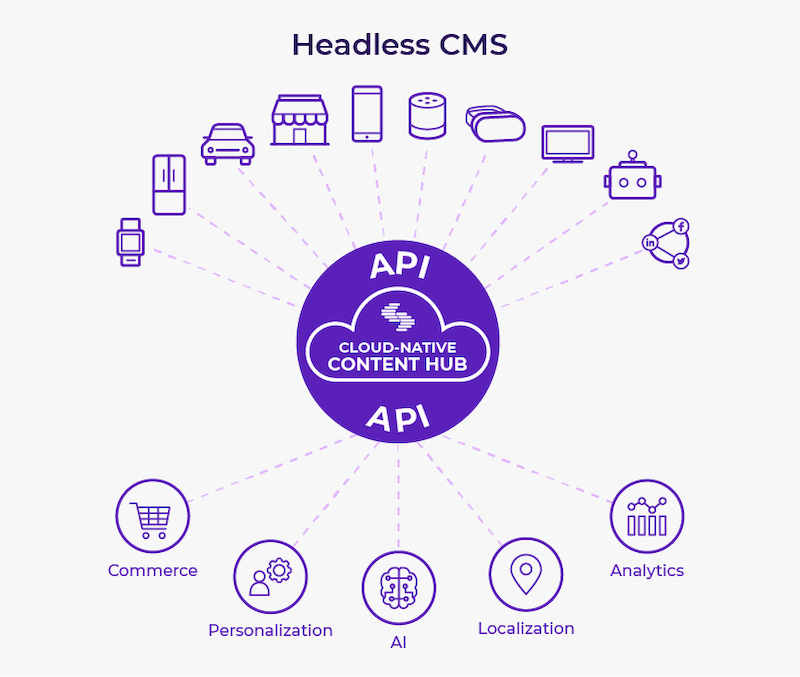
With a headless CMS, the presentation layer—including the content creation, management, and publishing—is decoupled from the backend. This decoupling empowers marketing teams to publish content and IT teams to push tech updates without waiting on each other.
Additionally, this modularity means that you can create content once and re-optimize the content using any personalization, localization, or other modern software of your choosing; and re-publish it. The modular approach ensures that content aligns with consumers’ needs, whether they’re interacting with a website or an app, end-cap kiosk, chatbot, or any other cutting-edge marketing channel.
Keep Learning About Omnichannel Experiences
Delightful omnichannel experiences don’t have to be few and far between in your marketing department. What’s more, modern brands are finding the shift to omnichannel experiences to be inevitable. This guide has given you everything you need to start making this transition. By implementing the strategies above, you can get a robust omnichannel marketing experience program off the ground in a few weeks.
Of course, there’s always more to learn. To further deepen your knowledge about the world of omnichannel marketing, check out these other articles:
Related Articles
Here are some CMS articles we think you'll find useful.
Everything You Need to Know About Contentstack
Discover Contentstack CMS features and benefits that add great value to businesses searching to simplify content delivery across all devices.
Read more
10 MUST KNOW CMS Development Trends
Review the most impactful web development trends of 2018 and beyond, and the advancements that will have a lasting impact on how development is done as a whole.
Read more
10 More Tips on How to Choose the Right CMS
To choose a CMS that’s right for your team – and to avoid from making beginner mistakes, follow these 10 tips when choosing a CMS for your team.
Read more
